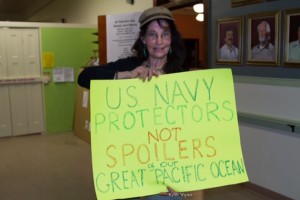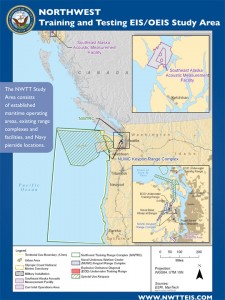Mendocino Coast Says No to Naval Weapons Testing!
A raucous and vocal crowd of local activists stormed the Redwood Coast Senior Center this past Friday Evening to give comments to the Navy’s Draft EIS for The Northwest Training & Testing
The Navy’s Proposed Action
 To ensure the Navy accomplishes its mission to maintain, train, and equip combat-ready military forces capable of winning wars, deterring aggression, and maintaining freedom of the seas, the Navy proposes to:
To ensure the Navy accomplishes its mission to maintain, train, and equip combat-ready military forces capable of winning wars, deterring aggression, and maintaining freedom of the seas, the Navy proposes to:
- Adjust training and testing activities from current levels to the level needed to support Navy requirements beginning October 2015.
- Accommodate evolving mission requirements associated with force structure changes, including those resulting from the development, testing, and introduction of new vessels, aircraft, and weapons systems.
Many of the training and testing activities evaluated in the NWTT EIS/OEIS have been analyzed by the Navy in previous environmental documents. The Northwest Training and Testing (NWTT) Environmental Impact Statement (EIS)/Overseas Environmental Impact Statement (OEIS) is being prepared to renew federal regulatory permits and authorizations for current training and testing activities and to propose future training and testing activities requiring environmental analysis. Click here for details regarding the Proposed Action and Alternatives.

Proposed Action
The Proposed Action would ensure the Navy accomplishes its mission to maintain, train and equip combat-ready military forces capable of winning wars, deterring aggression and maintaining freedom of the seas. This mission is achieved by conducting realistic training and testing activities in the Pacific Northwest. The Navy’s Proposed Action and alternatives will be evaluated in the NWTT EIS/OEIS to assess potential environmental impacts from proposed training and testing activities.

Through the NWTT EIS/OEIS, the Navy will:
- Reassess the environmental analyses of Navy at-sea training and testing activities contained in two previous EISs/OEISs and various environmental planning documents, and consolidate these analyses into a single environmental planning document. This reassessment will support reauthorization of permits under the Marine Mammal Protection Act and the Endangered Species Act. The two EIS/OEIS documents being consolidated are:
- Northwest Training Range Complex EIS/OEIS, completed with community input in 2010
- Naval Sea Systems Command Naval Undersea Warfare Center Keyport Range Complex Extension EIS/OEIS, completed with community input in 2010
- Adjust training and testing activities to support current and planned Navy requirements, including limited sonar use (high-frequency and not hull-mounted mid-frequency active sonar) in Puget Sound for homeland defense training activities. As part of the adjustment, the Navy proposes to account for other activities and sound sources previously covered in separate environmental analyses.
- Analyze the potential environmental impacts of training and testing activities in additional areas where they historically occur, including Navy ports and naval shipyards.
- Update the at-sea environmental impact analyses in the previous documents to account for force structure changes, including those resulting from the development, testing and use of weapons, vessels, aircraft and systems that will be operational prior to 2020.
- Update environmental analyses with the best available science and most current acoustic analysis methods to evaluate the potential effects of training and testing activities on the marine environment.

The National Environmental Policy Act (NEPA) requires federal agencies to evaluate a range of reasonable alternatives to achieve the purpose and need of the Proposed Action. Two “action” alternatives (Alternative 1 and Alternative 2) that meet the Navy’s purpose and need are currently under consideration. Analysis of a “no action” alternative is also required. These alternatives, and other reasonable alternatives identified during the scoping process, will be analyzed to help determine the appropriate level and type of training and testing activities to meet the Navy’s requirements.
No Action Alternative
Under the No Action Alternative, the Navy would continue current training and testing activities as defined by existing environmental planning documents, including the Northwest Training Range Complex EIS/OEIS and the Naval Sea Systems Command Naval Undersea Warfare Center Keyport Range Complex Extension EIS/OEIS. The baseline testing activities also include other testing events that historically occur in the NWTT Study Area (see Figure 1) and have been subject to previous analysis pursuant to NEPA and Executive Order 12114. Analysis of the No Action Alternative provides a baseline, enabling decision makers to compare the magnitude of the environmental effects of no action (current activities) to the effects of the action alternatives. Baseline activities do not include training with sonar in Puget Sound.
Alternative 1
Alternative 1 includes adjustments to types and levels from baseline activities conducted in the NWTT Study Area to support current and planned Navy at-sea training and testing requirements. Under Alternative 1, sink exercises would be eliminated.
Alternative 1 includes:
- Testing activities at Navy pierside locations in Puget Sound, the Carr Inlet Operations Area and the Southeast Alaska Acoustic Measurement Facility
- Mission requirements associated with force structure changes, including those resulting from the development, testing and introduction of new vessels, aircraft and weapons systems into the fleet
Alternative 1 includes some activities that were not analyzed in previous documents. New activities being considered include:
- Use of new and existing unmanned vehicles and their acoustic sensors, in support of homeland security and anti-terrorism/force protection. This type of training is critical in protecting the nation’s military and civilian harbors, ports and shipping lanes.
- Use of 0.50-caliber blanks in Puget Sound in support of force protection training of the Navy’s Maritime Expeditionary Security Force.
- Addition of a biennial maritime homeland defense mine countermeasure training exercise in Puget Sound and analyzing the amount of time acoustic sensors are used during that event.
Alternative 2
Alternative 2 includes all activities in Alternative 1 plus adjustments to the type and level of training and testing activities. Under Alternative 2, sink exercises would be eliminated.
Environmental Resources to be Analyzed
Some of the environmental resource areas and issues to be studied in the NWTT EIS/OEIS are listed below. The public is encouraged to provide input on these or other resource areas for consideration in the Draft EIS/OEIS.
http://www.navy.mil/submit/display.asp?story_id=78781
http://nwtteis.com/DocumentsandReferences/NWTTDocuments/DraftEISOEIS.aspx



[…] https://mendocinotv.com/2014/03/09/mendocino-coast-says-no-to-naval-weapons-testing/ Mendocino Coast Says NO to U.S. Navy Weapons Testing – March 7, 2014 – Fort Bragg, California […]
[…] pointed out how the Navy tried to use the same tactic in Mendocino, California, which was met with similar public outcry then as […]
[…] pointed out how the Navy tried to use the same tactic in Mendocino, California, which was met with similar public outcry then as […]